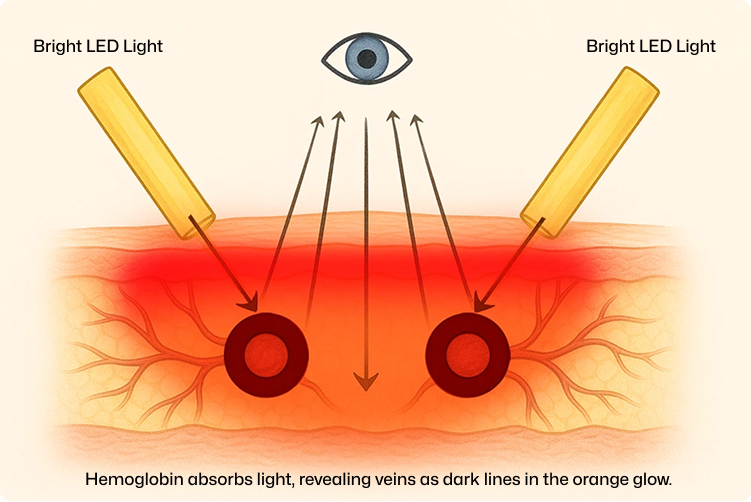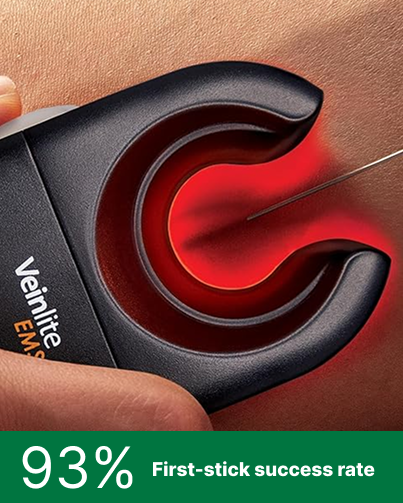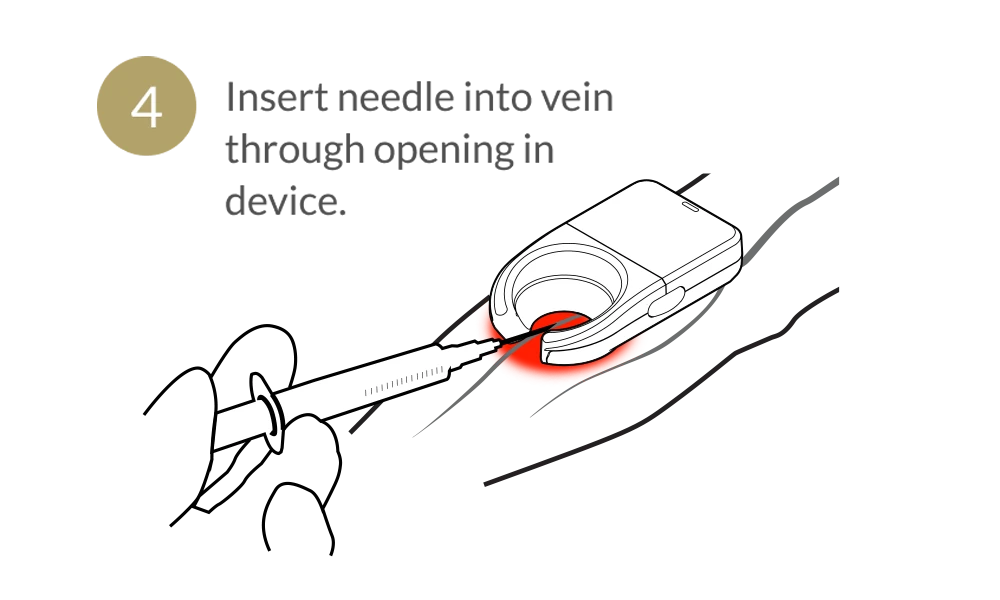The IV Access Challenge
Every medical professional knows the challenges: elderly patients, obese patients, dehydrated patients, dark skin tones, pediatric cases. Veins that are difficult or impossible to see with the naked eye.
The consequences of failed IV attempts:
- Patient pain and anxiety
- Delayed treatment
- Tissue damage from multiple sticks
- Lost time and resources
- Decreased confidence
With Veinlite devices, every patient interaction improves. Less pain and anxiety, easier venipuncture procedures, improved patient satisfaction and a more comfortable experience for all.
First-Stick Success Rate Comparison
What Makes Transillumination Different?
Veinlite uses high-intensity LED light to illuminate tissue from below. Blood absorbs this light, making veins appear as dark lines within the illuminated area.

Not Just Visualization – Stabilization
Not Just Visualization – Stabilization
Veinlite Is Easy to Use
No training required. Works immediately out of the box.
Average time to locate vein: 5-8 seconds
Why Transillumination Outperforms Near-Infrared Technology
No training required. Works immediately out of the box.
|
Veinlite |
Near-Infrared |
Standard
|
|
|---|---|---|---|
First-Stick Success |
93% |
45% |
72% |
What this means: |
93 of 100 patients |
45 of 100 patients |
72 of 100 patients |
How It Works |
Light passes through |
Projects image onto |
Visual & tactile |
Vein Stabilization |
✓
Built-in tourniquet |
✗
None |
✗
None |
Works On All Skin Tones |
✓
Equally effective |
✗
Limited performance. |
✗
Depends on contrast |
Training Required |
Immediate use |
1-2 hours orientation |
Years of experience |
Setup Time |
10 sec.
Apply plastic |
1-2 min |
None |
Ongoing Maintenance |
None |
Calibration,
|
None |
Cost |
$249-$679 |
$4,000+ |
$0 |
FDA Registation |
Since 1999 |
N/A |
Frequently Asked Questions
Isn't Veinlite just a fancy flashlight?
No. While both use light, the similarity ends there. Generic flashlights lack: - Optimal wavelength specifically chosen for hemoglobin absorption - Sufficient intensity to penetrate tissue up to 15mm deep - Proper light distribution pattern for even illumination - Vein stabilization capability through device pressure - FDA registration and clinical validation - Consistent, reliable performance (93% success rate) Veinlite's patented design delivers clinically proven results. Generic flashlights don't. If a simple flashlight worked as well, hospitals wouldn't invest in vein visualization technology.
What is transillumination technology?
Transillumination means "light passing through." Veinlite shines high-intensity light through skin and tissue from one side. Blood in veins absorbs this light, making veins appear as dark lines within the illuminated (orange-glowing) area. Think of it like backlighting: you're looking through the tissue rather than at the surface. This is fundamentally different from near-infrared devices that project images onto skin.
How deep can Veinlite penetrate?
Veinlite can visualize veins up to 15mm (approximately 0.6 inches) below the skin surface. This is sufficient for most peripheral IV access, including patients with: - Overlying adipose tissue - Edema - Deeper vessels - Challenging anatomy The actual depth depends on tissue density and composition, but Veinlite consistently reveals veins that are invisible to the naked eye and unreliable by palpation alone.
What is vein stabilization and why does it matter?
Vein stabilization (or "anchoring") is Veinlite's key advantage over near-infrared devices. When you hold Veinlite against skin, the device creates gentle pressure that: - Acts like a built-in tourniquet - Anchors the vein against deeper tissue - Prevents lateral rolling during needle insertion - Maintains vein position throughout the procedure This is critical because vein rolling is the #1 cause of failed IV attempts—especially with elderly, dehydrated, or fragile patients. Near-infrared devices show you WHERE the vein is, but don't prevent it from moving. Veinlite both shows AND stabilizes.
Does Veinlite work on all skin tones?
Yes, equally well on all skin tones. Transillumination passes light THROUGH tissue (including melanin in the epidermis) rather than projecting onto the surface. The light source and your eye are on opposite sides of the tissue, so skin pigmentation doesn't interfere with visualization. Near-infrared devices struggle with darker skin because they rely on surface reflection and image projection. Melanin absorbs much of their infrared light, reducing image quality. Clinical studies show Veinlite achieves 93% success rates regardless of patient skin tone.
How long does it take to learn how to use Veinlite?
Under 30 seconds for most clinicians. There's no training required. The process is intuitive: 1. Turn on the device 2. Place it against skin perpendicular to the vein direction 3. Veins appear immediately as dark lines 4. Rotate 90° parallel to the vein 5. Insert needle through the device opening If you can start an IV, you can use Veinlite. Unlike near-infrared devices that require calibration, positioning, and interpretation training, Veinlite works immediately out of the box.
Do I need to turn off the lights to use Veinlite?
No. Veinlite works in normal ambient lighting conditions, including bright overhead surgical lights. The LED intensity is sufficient to create clear visualization without requiring darkened rooms. This is a practical advantage over some near-infrared devices that perform better in dimmed lighting. Veinlite works in the real-world conditions of busy emergency departments, surgical suites, and patient rooms.









